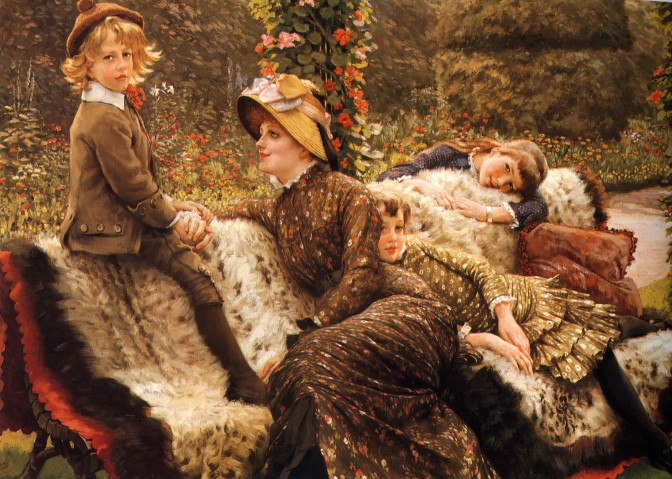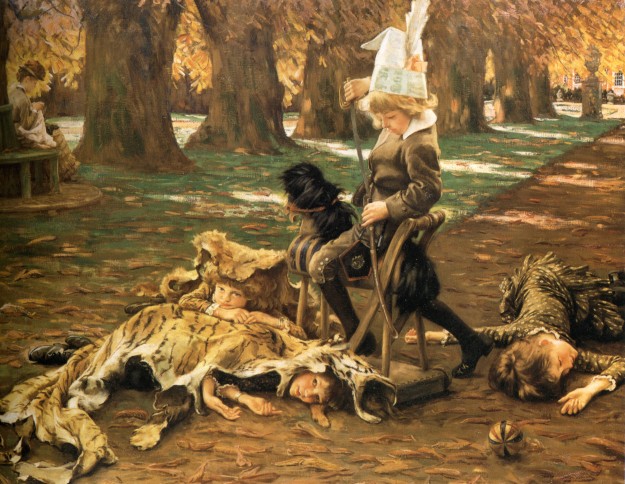To cite this article: Paquette, Lucy. “Tissot’s Tiger Skin: A Prominent Prop.” The Hammock. https://thehammocknovel.wordpress.com/2017/04/01/tissots-tiger-skin-a-prominent-prop/. <Date viewed.>
Since today is April Fool’s Day – and my birthday – let’s have a lighthearted look at a prop that James Tissot often used, a tiger skin.
In 1877, Tissot draped a tiger skin over a wide upholstered armchair to underscore the masculinity and dynamism of his sometime art dealer, Algernon Moses Marsden (1847 – 1920). [Marsden actually deserved to be portrayed with a rat skin, as he was a gambler, bankrupt and rogue who foisted his debts on his father and abandoned his wife and ten children. See Who was Algernon Moses Marsden?]

Algernon Moses Marsden (1877), by James Tissot. Private collection. (Photo credit: Wikipedia)
Other Victorian artists, notably Tissot’s friend Lawrence Alma-Tadema (1836 – 1912) as well as Alma-Tadema’s protégé John William Godward (1861 – 1922), featured tiger skins as an exotic element in sensual paintings of lovely women.

Cherries (1873), by Lawrence Alma-Tadema. Private Collection. (Image: Wikimedia.org)

The Priestess of Bacchus (1885-89), by John Maler Collier (1850-1934). (Image: Wikimedia.org)

The Sweet Siesta of a Summer Day (1891), by John William Godward. (Image: Wikimedia.org)

Dolce Far Niente (1897), by John William Godward. (Image: Wikimedia.org)

Eighty and Eighteen (1898), by John William Godward. (Image: Wikimedia.org)
James Tissot, so technically skilled and refined, almost never presented open sensuality in his work, especially during the years he painted in England (1871–1882). He used the tiger skin in his paintings for textural complexity and to illustrate the lushness of the Victorian leisured life. After Tissot’s mistress and muse, Kathleen Newton (1854–1882), moved into his home, he added a leopard skin rug to his prop collection.
In Hide and Seek (c. 1877), Tissot featured both the leopard skin and the tiger skin, among many textures including the Oriental porcelain, the two mirrors, the leather-armed chaise, the polished wooden occasional table, and the round enameled table in the foreground.

Hide and Seek (c. 1877), by James Tissot. National Gallery of Art, Washington, D.C. Courtesy of The Bridgeman Art Library for use in “The Hammock: A novel based on the true story of French painter James Tissot” by Lucy Paquette © 2012
In Reading a Story (c. 1878-79), the leopard skin is tossed over a bench in Tissot’s garden:

Reading a Story (c. 1878-79), by James Tissot. Private Collection. (Image: Wikiart.org)
In 1880, it lines Mrs. Newton’s chair in A Type of Beauty.

A Type of Beauty (Portrait of Kathleen Newton, 1880), by James Tissot. Private Collection. (Image: Wikipedia.org).
The leopard skin is draped neatly over the garden bench in pictures from 1881 to 1882:

Quiet (c. 1881), by James Tissot. Private Collection. (Image: Wikiart.org)

Le banc de jardin/The Garden Bench (1882), by James Tissot. Oil on canvas, 99.1 by 142.2 cm. Private collection. (Photo: Wikiart)
Tissot also shows the leopard skin used as the family picnic rug, c. 1881.

In Full Sunlight (En plein soleil, c. 1881), by James Tissot. Courtesy Metropolitan Museum of Art, New York, Open Access.
How prim Tissot, the Frenchman, seems compared to the Dutch-born Alma-Tadema!

The Tepidarium (1881), by Lawrence Alma-Tadema. (Image: Wikimedia.org)
By 1882, enjoying his domestic life with Kathleen Newton and her two children, Tissot’s tiger skin is emblematic of the exuberance of their days – which would end with Kathleen’s death of tuberculosis in November.

Le Petit Nemrod (A Little Nimrod), c. 1882, by James Tissot. Oil on canvas, 34 ½ by 55 3/5 in. (110.5 by 141.3 cm). Musée des Beaux-Arts et d’archéologie, Besançon, France. (Photo: Wikipaintings.org)
But while James Tissot did not use his tiger skin in erotic images, he did use it to create one with an improving moral message.

Triumph of Will: The Challenge (1877), by James Tissot. (Image: Wikiart.org)
Even in La femme préhistorique (The Prehistoric Woman), Tissot shuns the opportunity to paint an erotic semi-nude primitive; he veers off with his own idiosyncratic approach.

La femme prehistorique, by James Tissot. (Image: Wikimedia.org)
But, then, at least Tissot never inflicted this type of image upon posterity:

Autumn Flowers, by Jehan Georges Vibert (1840 – 1902). (Image: Wikiart.org)
Thank you for celebrating my birthday with me, and please enjoy other posts on my blog as well as my novel about James Tissot, The Hammock!
Previous April Fool’s Day posts:
Was James Tissot a Plagiarist?
Tissot and his Friends Clown Around
© 2017 by Lucy Paquette. All rights reserved.
The articles published on this blog are copyrighted by Lucy Paquette. An article or any portion of it may not be reproduced in any medium or transmitted in any form, electronic or mechanical, without the author’s permission. You are welcome to cite or quote from an article provided you give full acknowledgement to the author.
 If you do not have a Kindle e-reader, you may download free Kindle reading apps for PCs, Smartphones, tablets, and the Kindle Cloud Reader to read The Hammock: A novel based on the true story of French painter James Tissot. Read reviews.
If you do not have a Kindle e-reader, you may download free Kindle reading apps for PCs, Smartphones, tablets, and the Kindle Cloud Reader to read The Hammock: A novel based on the true story of French painter James Tissot. Read reviews.
The Hammock: A novel based on the true story of French painter James Tissot, brings Tissot’s world from 1870 to 1879 alive in a story of war, art, Society glamour, love, scandal, and tragedy.
Illustrated with 17 stunning, high-resolution fine art images in full color
Courtesy of The Bridgeman Art Library
(295 pages; ISBN (ePub): 978-0-615-68267-9). See http://www.amazon.com/dp/B009P5RYVE.